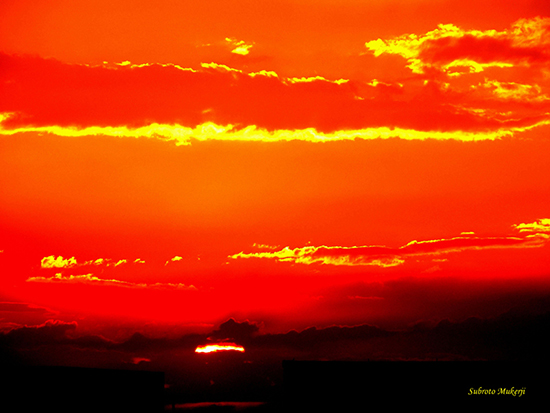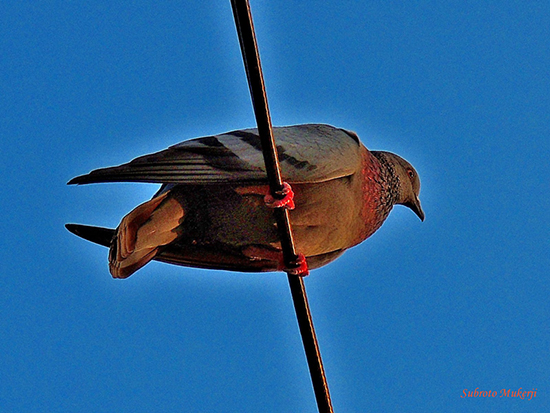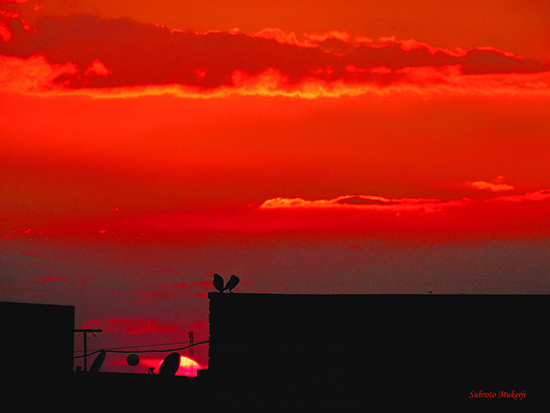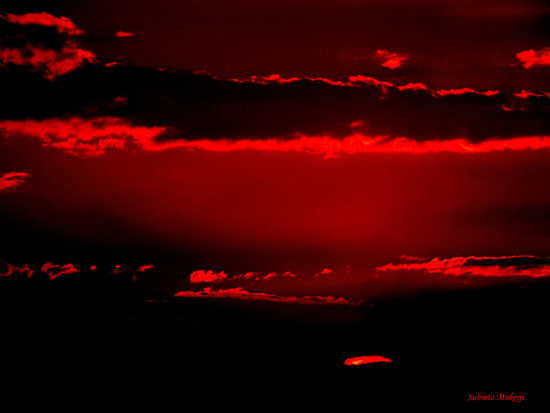
Author’s Intro: This is a guest post by Subroto Mukherjee. Subroto is an amateur photographer and has taken up photography as a passion. Apart from that he loves to read, write and explore more about photography; more from the technical aspect though.
Beats there the heart so calloused by life’s ups and downs, by the monotony of daily existence, that it cannot appreciate a glorious sunset? I ask this rhetorical question to drive home the fact that a magnificent sunset can be uplifting and rejuvenating, if not a surreal or even a spiritual experience.
Way back in 1977, a photograph entitled Leopard at sunset in one of the volumes of the Life Library of Photography had brought me alive to the possibility of sunsets. That amazing picture is permanently embedded in the mysterious memory banks of my brain.
The picture depicts a leopard in a tree, standing menacingly over a gazelle it has just killed and dragged into the lower branches. The limp form of the little gazelle and the hunched figure of the fearsome predator are silhouetted against the gigantic sun — immense red ball of fire — the sun so big that it practically fills the 35mm Kodachrome 64 frame. 2,000 mm or more of magnification, a Nikon F2AS Photomic coupled with superb composition and exposure had produced a masterpiece of wildlife photography.
Cut to 5th September 2012. Something made me drag my eyes away from my monitor. The walls of my room were flooded with orange light. Instantly realizing what was happening, I grabbed a camera and ran upstairs to the terrace. My heartbeat accelerated as I glanced at the scene — a glorious sunset was on the cards!

The sky was ablaze with vibrant colors. Swirling air currents in the upper reaches of Earth’s atmosphere due to the cessation of the monsoons had given rise to a random phenomenon where the air was particularly prismatic in character. Amazing cloud patterns drifted among updraughts of earth-warmed air colliding with cooling layers to produce kaleidoscopic effects. I gazed at the spectacle for a while before I suddenly remembered what I was there for…
I zoomed out to the widest setting — 24 mm — that my lens was capable of and began shooting at the lowest ISO setting, varying the focal length and composition occasionally while relying on the camera’s in-built exposure meter to give me the slight under-exposure I needed to preserve the highlights (a hangover from my Kodachrome days, it works quite well in digital photography as well). Check out more tips on shooting wild sunsets here. I had also taken the precaution of setting the picture control to Vivid and I got more than I’d bargained for!

Even as I shot frame after frame in rapid succession (oh the joys of digital photography!), I was keenly aware that I was unlikely to ever see again such a splendid sunset.
My eyes refused to believe what was happening as I recorded the multiple shades of reds, the churning yellows and authentic golds that somehow managed to survive in that boiling, frothing cauldron of wild, untamed color as the sun sank into its fiery bed beyond the horizon.
This was the nature at her rawest; the nature in her most primitive mood. It reminded me of what I’d read of the fledgling Earth — 4 billion years ago, with seas of liquid magma cooling over the eons to finally transform into a green and watery planet — our beautiful home planet.
Happening to look up, I saw another life form gazing at the heavenly spectacle with rapt attention…

Now the sun was sinking fast, as it always does in the tropics. Those who remember their schoolboy geography will recall that the circumference of the earth at the equator is 40,070 kilometers, and as the day is 24 hours long, the equatorial speed of rotation is 1670 kilometers/hour (1070 miles/hr). This explains why the sun seems to set faster, the closer you are to the equator.
I shot on, knowing quite well that the dynamic range of my camera’s digital sensor would only be able to record a fraction of the DR that my eyes were seeing. The human eye is a highly sophisticated optical device that has evolved over 3 billion years of evolution, so we must excuse camera manufacturers, who’ve been tinkering with their technology for only a few decades.
The mesmerizing sunset kept unfolding its beauty every minute and I enjoyed taking a peek with my camera and capturing the colorful hues and also, photographing the silhouettes.

All the nature seemed to be holding its breath as the sun died in the west. Then it was gone, and only a few glowing embers spoke of its vanished glory.
I kept shooting frame after frame as the sun sank rapidly out of sight below the horizon, leaving the world to darkness and to me.

Author’s Intro: This is a guest post by Subroto Mukherjee. Subroto is an amateur photographer and has taken up photography as a passion. Apart from that he loves to read, write and explore more about photography; more from the technical aspect though.

